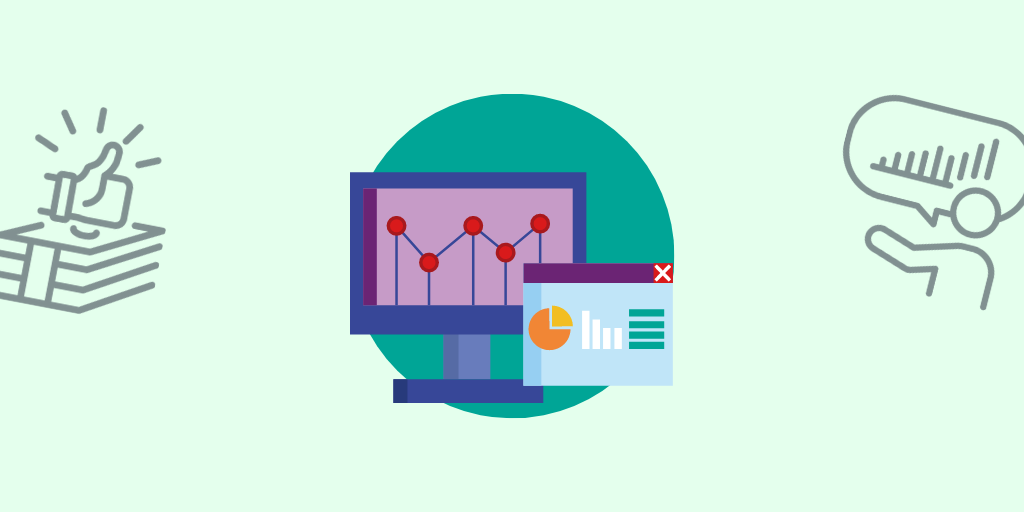Every project has a life cycle.
No matter if you are a project or marketing manager, designer or developer, understanding the project life cycle will help you streamline processes, save money, time and, above all, achieve better results.
When should you use a predictive life cycle? When is more flexibility the better option? And how can you balance the time, scope, and costs of your project?
From project planning to the closing phase: This article goes into detail and dissects each of the five project life cycle phases.
You will gain a clear understanding of how to structure, execute and monitor your projects.
What is a project management life cycle?
The project life cycle provides a structure for the timeline of each project and is a crucial part of project management best practices.
It’s divided into different high-level project management phases, which are broken down further into milestones and processes.
Traditionally, the project life cycle was used by project managers to structure and keep track of the project budget and project schedule.
Nowadays, the concept is used by virtually all functions.
One great thing about the project life cycle is its compatibility with almost all industries and projects. No matter if you are working on a marketing project or you need to code a website, the project life cycle is a great tool to structure your project from start to finish.
Even though life cycles vary according to project scope, goals, project team members, clients and industry, there are still many similarities, which all projects have in common.
What is project life cycle PMP (Project Management Professional)? The project management book “Project Management Body of Knowledge” (PMBOK® Guide) of the Project Management Institute (PMI) offers great guidelines of what the project life cycle should define:
- What work do you need to accomplish?
- What are the deliverables?
- Who are the project stakeholders or team members?
- How do you plan to review and approve each phase?
As you can already see, the project life cycle is a valuable tool, which can be applied to multiple purposes.
The next section will give you a better understanding of why the project life cycle is crucial to the success of your next project.
Why is the project life cycle important?
Critics might say that the project management life cycle is too general to be applied to very specific projects.
However, if you take a closer look, you will find a conceptualization and planning phase, as well as performance tracking in all projects.
The project life cycle offers a good start to any project, as it takes a high-level approach and lets you easily structure even very specific projects, according to its five distinct phases.
By making use of the project life cycle, it’s much more likely that your upcoming project will be successful.
The reasons are manifold:
Clear structure
You can structure your project from start to finish, identify bottlenecks and allocate resources.
Transparent KPIs
The project life cycle encourages you to set up clear deliverables and KPIs, which is paramount for your project success.
Communication plan
Setting up a clear communication structure from the get-go enables all stakeholders and the project team to participate more efficiently in the planning and execution process.
Performance reviews
Clear KPIs allow you to track project performance at any phase of the project and objectively evaluate the final outcome.
By establishing a clear project strategy in the earlier stages of the project, you will have a much better understanding of the processes involved and can better anticipate challenges that may come up along the way.
Even if you use an adaptive (or agile) approach, it’s recommended to plan your projects in the first place and leave space for changes as the project progresses.
The result will speak for itself: You can achieve higher quality of the final product, a faster turnaround time and cost savings.
The five phases of the project life cycle
The most important question is: What are the five stages of the project life cycle?
The project life cycle usually consists of five distinct project management phases, which encompass the entire project from start to finish:
- Conception and initiation
- Scope and budgeting
- Launch or execution
- Performance and control
- Project closure
Some people ignore the performance and control phase and argue that the typical life cycle only consists of four project phases.
Even though you can still finish your project while omitting this phase, you won’t have any indicators as to how well your project is performing. You will also not be able to draw relevant conclusions for your next projects.
Therefore, a good project manager should follow all five project management steps, in order to turn the project into a success.
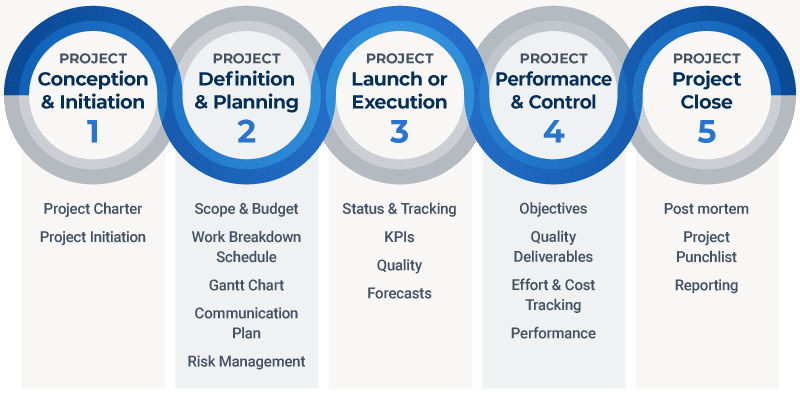
Phase 1: Concept and project initiation
This phase establishes the project roadmap.
It aims at defining the entire project at a macro level, according to the above-mentioned guidelines of the Project Management Institute.
When the project begins, the project manager will discuss the business case, project goals and also possible deliverables with the most important project stakeholders. This might differ, depending on the size and nature of the particular project.
At the end of this stage, you should produce a document, which summarizes the initial project design. You can either use a project charter template or go much more into detail with a project initiation document (PID).
Project charter
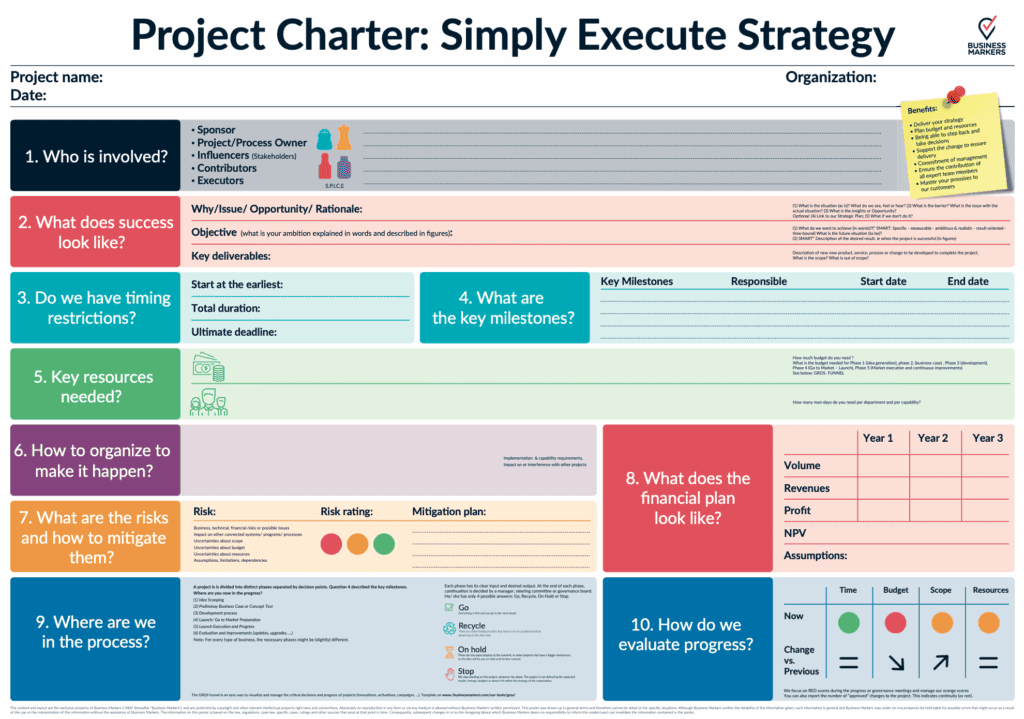
As can be seen from the picture above, a project charter offers a short overview of all important information for the project. This may include stakeholders, KPIs, a rough timeline and budget plan. The project charter is usually the first official document produced in the life cycle.
Project initiation document (PID)
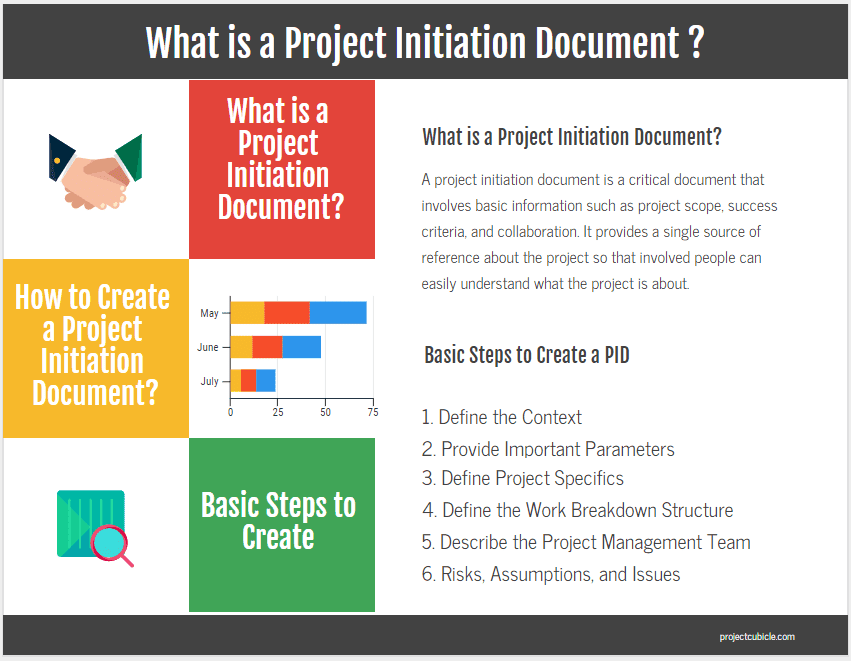
Alternatively, you might go much more into detail by creating a project initiation document (PID), which may include risk assessment, resource management and contingency plans. The PID is usually produced in a predictive life cycle, with few unknown variables.
Phase 2: Definition and planning stage
While the concept and initiation phase mainly consists of high-level planning, the definition and planning phase clarifies more details.
This may include:
Scope and budgeting
No project plan is complete without a thorough project scope and budget plan. The project scope contains project deliverables, acceptance criteria, activities, project processes and boundaries. The budgeting plan should list all possible expenses for every process involved.
Work breakdown schedule
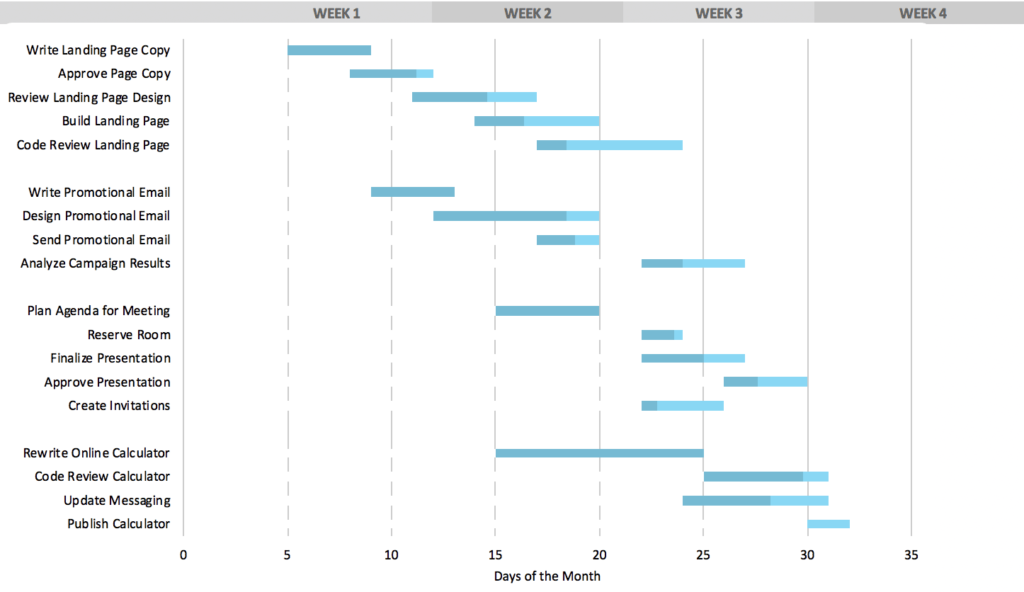
How can you structure your entire project schedule without getting lost in too many details? This is where Gantt charts come into play. Gantt charts allow you to structure your projects according to milestones and their required timelines. Project management software tools and a project plan can support you to visualize your work breakdown schedule.
Communication plan for project managers and stakeholders
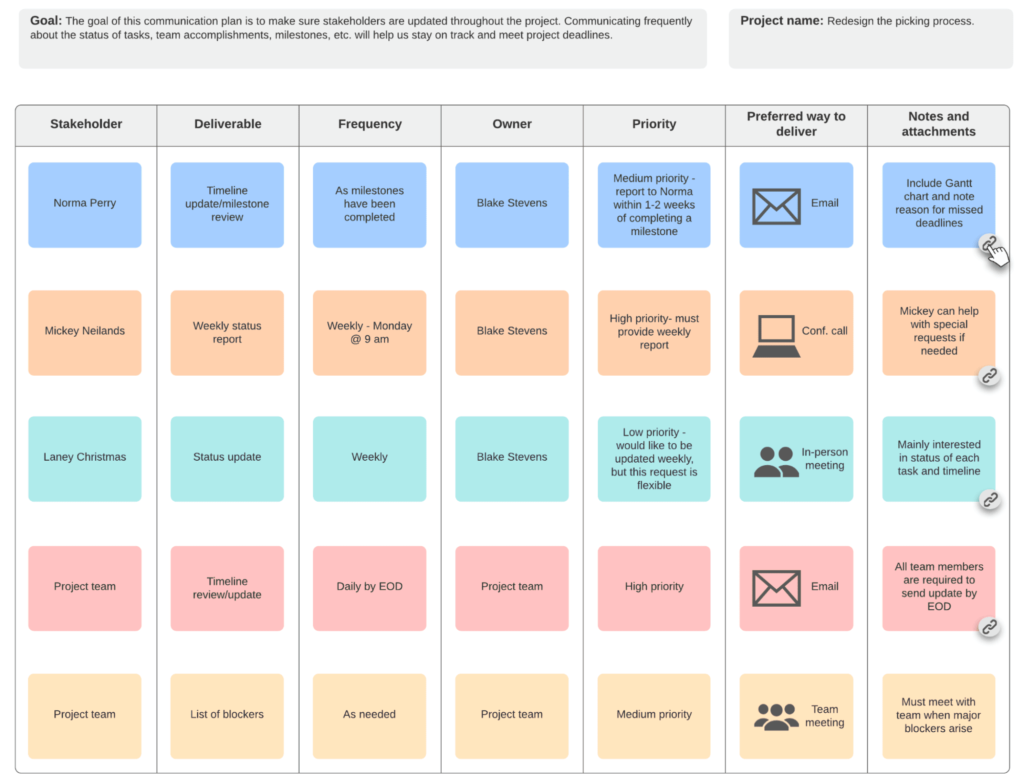
Projects depend on the interaction between multiple stakeholders. As a general rule of thumb: The more complex a project, the more important it’s to create a communication plan for all project team members involved.
Team members can include company stakeholders, as well as project sponsors, customers, suppliers, distributors or other project team members across the supply chain. A good communication plan should therefore include responsibilities, meeting schedules and contact information for all participants.
Risk management
Depending on the nature of the project, project managers should determine the most likely risks involved and establish contingency plans. Contingency plans will help the organization change direction, in case something does not go according to the original plan.
Phase 3: Launch or project execution
After you have meticulously planned your project management process, you can put your project plan into action during the project execution phase. While the first two phases provide you with a suitable structure, the execution phase aims at achieving your project objectives.
This is where a lot of things are happening: You usually start with a project kickoff meeting to discuss all the details with your stakeholders. Once the implementation phase / execution phase has started, you need to keep track of multiple indicators.
Project status and tracking
You need to regularly check the status of all tasks to achieve certain milestones. This includes regular meetings with all stakeholders and a proactive approach, in case something does not work according to plan.
KPIs
When implementing your project, KPIs will help you stay on track and measure the success of your project. KPIs usually include certain quality standards, which need to be achieved. Depending on the project, KPIs may also include sales conversions or number of views.
Quality
Quality management does not only take place at the final stage, but throughout the entire project management life cycle. Make sure you have reliable quality control measures in place to track progress of the project management process.
If you produce digital content, such as contracts, music, or even videos, review and approval software, such as Filestage, makes it easy to collect feedback and approvals. All stakeholders can leave comments and annotations directly on the file and discuss the content with other reviewers, in one single place. This way, you can ensure that every content piece is mistake-free, brand-compliant, and meets all requirements.
Forecasts
According to your status tracking, KPIs, and quality controls, you will be able to make reliable forecasts about the duration and outcome of the project management life cycle. Are you on track or do you need to adjust your schedule? Make sure everybody is up to date regarding new changes.
Phase 4: Performance and control
As initially mentioned, some project managers only structure their projects according to four phases and omit the project performance and control phase. While all other phases run consecutively, the performance and control phase takes place at the same time as the execution phase.
Phase four serves as a project monitoring and quality assurance phase so that changes in phase three can quickly be implemented if things do not go according to plan.
Check objectives
During the project, you need to continuously check whether the project’s objectives can still be achieved. This includes the work in progress of all project management phases, as well as budget and time considerations.
Check quality deliverables
Milestones offer a great way to check whether you are on track. No matter whether you are developing a product or working on a marketing campaign, make sure to check the deliverables at least at every milestone.
A tool like Filestage makes it easy to share the deliverable with all reviewers and collect feedback, in one place. Plus, stakeholders can approve files with just one click, making your review rounds faster and more transparent.
Check KPIs
During the implementation phase, you need to compare the KPIs with the current work in progress, to make sure the desired outcome can be achieved. Therefore, you should not only use KPIs for the final product but also establish performance measures for processes and milestones.
Phase 5: Project closure
After you have implemented your project and tracked its progress, you are ready for the final phase of the project management life cycle. The completion phase mainly involves paperwork and drawing conclusions for future projects.
Project punch list
A punch list consists of secondary tasks or project remains, which need to be completed before the closure phase is over. This might consist of paying off third parties and professional services teams or checking off other minor tasks, which have not been finished before project completion.
Project manager reporting
After successful completion, the report is indispensable for future learning. The project manager summarizes all important KPIs and states whether the project deliverables meet the project demands. The more honest project managers are about their shortcomings and the more failure tolerant a company is, the better the learning process.
What are the different types of project life cycle?
You should be aware that there are two different forms of life cycles.
While the predictive life cycle plans everything from start to finish and sticks to the initial project plan, the adaptive life cycle leaves more room for change.
Predictive life cycle
As the name suggests, predictive life cycles contain fewer unknown variables, so you can easily plan your project from start to finish. You can further reduce complexity by creating a thorough project initiation document (PID) at the start of your project.
One of the most famous predictive life cycle methodologies is the waterfall approach.
Waterfall methodologies often break projects into distinct, sequential phases that logically move the project along. This compartmentalization will result in a clear, distinct project life cycle that every team member can follow.

The four-step project life cycle outlined above naturally lends itself well to projects that utilize a waterfall methodology. So project managers generally use this type of methodology to plan the project.
Adaptive life cycle
Compared to waterfall approaches, adaptive life cycles are subject to change. During the project, milestones can be rearranged or taken out altogether. Even the final outcome can be subject to change. Adaptive life cycles are used when the outcome of a project cannot be determined at the beginning.
This is the reason why proponents of the adaptive life cycle spend less time on the planning stage, as the project naturally develops through iterations and review lessons.
Methodologies for agile project management are particularly popular among development teams. Compared to waterfall methodologies, they’re less deliberate and detailed. These agile methodologies focus on using scope flexibility and continuous improvement to adjust projects over time.

Often, agile project life cycles are more complex and imaginative. Since there is a range of templates for agile project life cycles out there, many teams will call on key principles to develop their own.
What is the project management triangle?
In a perfect world, the project manager has all they need to finish a project, knows exactly what work needs to be done, and has a clear overview of the budget required. Unfortunately, no matter how well your planning phase and project plan have been executed, you can be sure that a lot of things will not go according to plan.
Your project costs may increase, additional work may shift your initial project scope or you may realize you are running out of time. Or all these things may happen at once. These three constraints form the project management triangle.
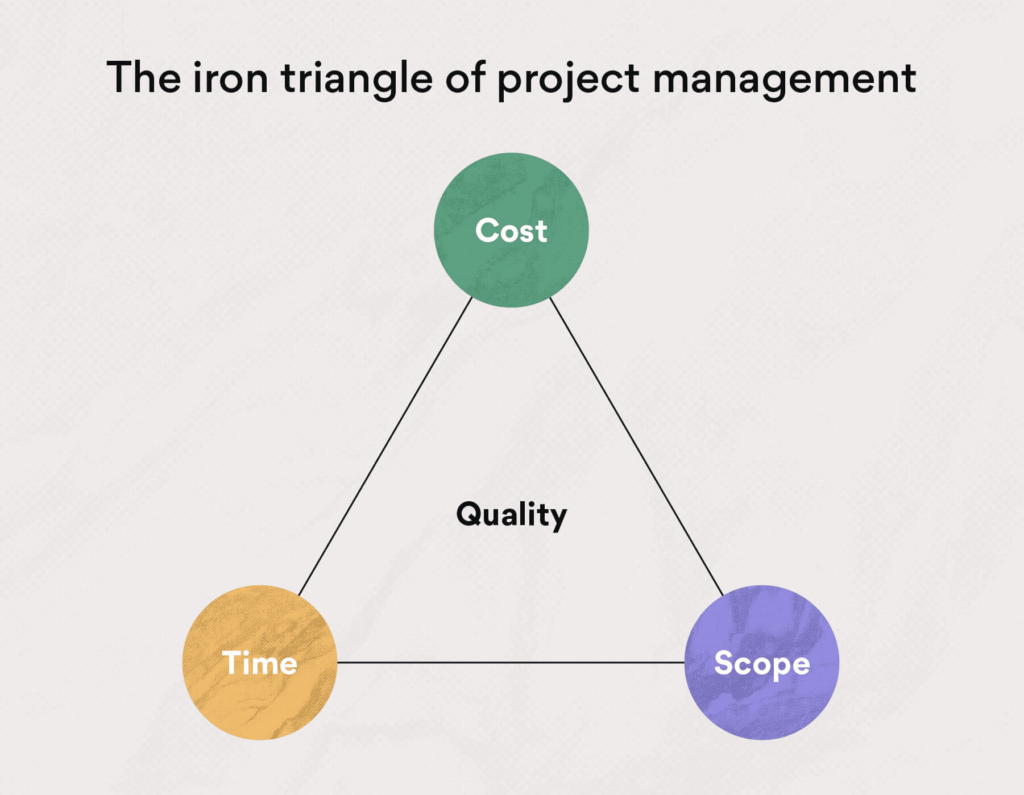
As the picture suggests, time, scope, and cost determine the quality of your project. Each shift in one of those variables can therefore jeopardize your milestones or final deliverables.
Time
Time refers to the timeframe needed to finish the entire project. A project manager breaks down all milestones and processes so that they can estimate and add up all timeframes. Gantt charts offer a clear overview of how long each milestone takes and show the interdependencies of all tasks involved. Besides, a project manager can make use of multiple tools, such as PERT charts, to better control the time variable.
Scope
The scope of a project describes all the work to be done, in order to achieve the final result. Here, you can already see an interdependency: The broader the scope (i.e. the more workload to be completed), the longer the time it will take to finish the entire project.
Cost
Costs encompass the overall budget of a project, from start to finish. This may include salaries, manufacturing costs, materials, third parties, and any other costs involved. Here, you can see another dependency: The more time or workload required, the higher the costs.
The right balance between time, scope and cost
As you can see, you need to make sure that the triple constraints are clear from the beginning, as if one changes, so do the others. This will affect the quality of your project and jeopardize the final success of the project. You can find out more about the right balance in the following depiction:

If you need to add more workload, you need to add more costs and time and also find the right balance between these two variables. Therefore, make sure you have everything sorted out from the get-go, in order not to have to re-balance the triangle multiple times during your project.
Project life cycle vs product life cycle
When it comes to differentiating between the project life cycle and the product life cycle, there’s often some confusion. We already have a pretty in-depth understanding of the project life cycle. So, to fully see the difference, let’s take a closer look at the product life cycle.
Essentially, the product life cycle refers to everything that falls between the inception of an idea and the retirement of the idea. For example, you might find that a business’ website could be viewed in terms of a product life cycle.
A product life cycle is composed of project life cycles. These smaller cycles occur in a sequence that moves the product life cycle along its stages. Generally, they include:
- Development
- Introduction
- Growth
- Maturity
- Retirement
Marketing project managers of all kinds frequently interact with the project life cycle. But there may be instances when they have to understand the product life cycle, in order to effectively market certain products and services.
A keen understanding of the product life cycle can help marketing project managers boost their results and forge deeper connections with their clients and the project sponsor.
Project management example: Marketing campaign life cycle
Marketing campaigns of all shapes and sizes can help your business grow and expand its reach. If you’re going to achieve the best possible results, you will need to think about how to shape the project’s life cycle.
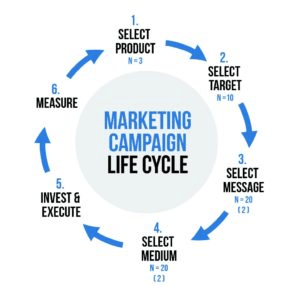
The marketing campaign life cycle fits perfectly into our five phases of the project management life cycle. This shows that the general model is flexible and can be applied to a wide range of industries. The following example shows all marketing project phases.
Project initiation phase
If you decide to launch a marketing campaign, you have to be prepared. So you should use the initiation phase to precisely define the project goals of your campaign.
Project planning
The seeds of success are planted during the project planning phase of any marketing campaign. To create a deliberate and effective campaign, you should create detailed timelines and budget projections for your business case. During the strategic planning stage, it’s particularly important to establish milestones, given that these will guide the project management process.
Project execution phase
It’s critical to report and communicate while you’re planning. On the one hand, project managers will want to find the right tools for producing detailed, clear reports. On the other hand, these project managers will want to find an effective way to communicate their results with stakeholders during the execution phase.
Performance and control
While final KPIs, such as viewership or sales conversion, can only be controlled at the end, you can make sure that all project management steps work according to plan. This includes regular meetings with internal stakeholders or external advertising agencies. Once your project is finished, you can take a look at the KPIs, to evaluate the success of your project.
Project closure phase
The closure phase of the project management life cycle gives project managers the opportunity to consolidate the lessons they’ve learned and the project results in one place. So, the project manager should assess the performance of the project and tidily stow away any associated collaterals.
Conclusion
Managing projects requires a combination of practical skills and granular planning. Mastering the project management life cycle is the first step to a successful project. Make sure to start your project at the macro level and gradually dig deeper into all the details of your project.
As the project management life cycle is not a one-size-fits-all solution, the project manager needs to mold the project roadmap, project management stages, project resources and all other variables, to manage projects efficiently.
We hope this blog entry has given you valuable insight into how to achieve project success and execute future projects with ease.

